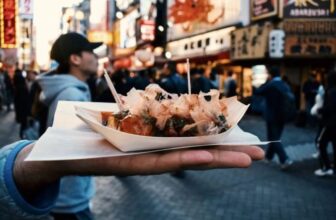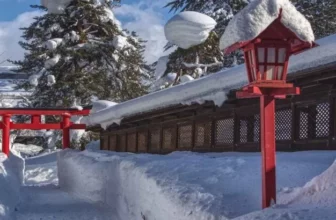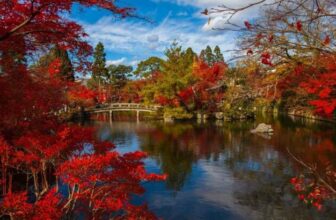Japan is a popular destination throughout the year, with many eccentric attractions and seasonal activities. Spring in Japan brings lush vegetation, cherry blossoms, and ideal weather, with many festivals and celebrations ushering in the season.
Read on to discover why spring is such a great time to visit and some of the best things to do in Japan that you can include in your itinerary.
Weather
Springtime in Japan is from March to May. This is the most popular season for travel, sightseeing, and exploration due to the delightful, breezy temperatures and lush greenery.
Chilly nights and rain are still typical in the first month of spring. In March, the average temperature ranges between 40℉ and 50℉. From April onwards, bright skies and sunny days become more frequent as the season progresses. Occasional rain showers can also be expected. Temperatures begin to pick up to an average of 60℉ and 70℉ in May as you head into Summer in Japan.
Top Activities in Spring in Japan
Japan may be small, but it’s not short of fun things to do across a diverse landscape.
Hinamatsuri Festival, Katsuura

Hinamatsuri is a religious Shinto holiday that takes place annually on the third of March. Celebrations are held all over the country, with the most popular festival taking place in the small seaside town of Katsuura.
Doll’s Day is a celebration where large groups gather with blessings and prayers for the health, future prosperity, and happiness of young girls or daughters. Traditional Hani dolls are presented to young girls as a symbol of protection.
During the week-long Hinamatsuri Festival in Katsuura, as many as twenty-five thousand Hani dolls are displayed throughout the brightly-decorated town. Festivities include Japanese dance and song performances, traditional tea ceremonies, and authentic handmade craft fairs.
Kyo Odori, Kyoto

Kyoto is known as the cultural capital of Japan, with many Buddhist and Shinto shrines, as well as its acclaimed geisha district, Miyagawa-chō. Every April, the maiko (apprentice geishas) and geiko (geisha in Kyoto dialect) put on a spectacular Japanese springtime show.
Kyo Odori is a charming, colorful performance that celebrates the arrival of spring through song and dance. It’s a unique seasonal experience, as geishas rarely perform in public.
Dances combine traditional costumes, breathtaking stage scenery, and live music into a spectacular celebration of Japanese culture and tradition.
Kameido Tenjin Shrine Wisteria Festival, Koto City

Cherry blossoms are not the only celebrated flowers in Japan. In mid-April, Koto City hosts the annual Wisteria Festival at the Kameido Tenjin Shrine. The shrine’s beautiful gardens and turtle-filled ponds are covered in purple Wisteria blossoms.
The shrine is an acclaimed attraction dating back to 1661, dedicated to the 9th Century Japanese poet and scholar, Sugawara Michizane. During the festival, there are special events honoring him as the patron of learning. Students of all ages participate in laying down flowers and gifts in the hope that higher powers will help them do well in exams.
A light-up flower ceremony is held every night of the festival, giving a mystical atmosphere to the celebrations. Traditional food and drinks, souvenirs, and crafts are available for purchase.
Kanda Matsuri, Tokyo

Kanda Matsuri is an annual spring festival with ancient roots dating back to the 17th Century. This week-long festival in May includes a parade, traditional costumes, and festive live music. The festival’s main attraction is the day-long parade through central Tokyo. It’s a celebration for attracting wealth and good fortune to the people of Japan.
Festival floats are ordained with spring flowers and characters from popular folk stories. The parade is led by priests on horses, men in samurai uniforms, and traditional musicians and dancers. The festival has a joyful atmosphere, upbeat music, and colorful costumes that you’ll absolutely love.
Matsuyama Spring Festival, Shikoku Island

The Masuyama Spring Festival is a renowned cultural heritage celebration in early April. It makes for a fantastic activity thanks to the warm weather and the spring blossoms bursting to life.
The festival kicks off at Matsuyama Castle with a Shinto ceremony blessing the Lord and Lady of the castle, and the procession then proceeds through the town. Performers dress in historical garments and dance and sing through the streets, some playing on traditional hand-carved flutes.
The festival ends on a high note with a spectacular lion dance in front of the castle, accompanied by fireworks and confetti. If you want to immerse yourself in ancient Japanese culture and tradition, this festival is not to be missed.
Top Places to Visit in Spring in Japan
Handayama Botanical Garden, Okayama City

The Handayama Botanical Garden is a nature lover’s paradise during springtime. This breathtaking garden sits on a hill with sweeping views of Okayama City and an abundance of pink cherry blossoms.
There are many spectacular spots to enjoy the quiet, unspoiled natural landscapes. You can relax next to a picturesque pond with enormous floating lilypads or explore rare tropical plants in the greenhouse enclosures.
The garden also has numerous walking paths that provide the opportunity to explore a wide variety of plants and blossoming trees. There is also a charming souvenir shop where you can purchase handmade crafts.
Kamakura, Kanagawa

The coastal town of Kamakura is known for its numerous Buddhist shrines and temples and many amazing natural areas. The most popular attraction is the forty-three-foot-high bronze Buddha statue at the Kotoku-in Temple.
During spring, Kamakura’s beautiful sandy beaches are the main attraction, with gorgeous swimming, sunbathing, and surfing spots. The beaches are lined with barbeque cafes and beer gardens, ensuring a delightful day of fun in the sun.
Asakusa, Taitō

Asakusa is a vibrant cultural district adjacent to Tokyo. It is also home to the prominent Sensō-Ji, a Buddhist temple built more than a thousand years ago. The area is a great destination to soak in the rich history and traditional cultures of Japan.
Nakamise Shopping Street is a popular market that connects to Sensō-Ji temple’s main gate. The street is lined with cherry blossoms during spring, providing a colorful and unique shopping experience. Traditional craft shops and street food stalls are plentiful, and you’re guaranteed to find high-quality souvenirs at reasonable prices.
Yoshino, Nara

The beauty of Yoshino’s varying landscapes and breathtaking scenery has inspired poets and artists for centuries. With over thirty thousand cherry trees painting the area pink, it is easy to understand why it is the most visited springtime destination in Japan.
The town nestles in the valleys of Mount Yoshino, which offers spectacular views and many exciting outdoor activities. The cool, clear water of Lake Tsuburo is perfect for swimming, canoeing, and fishing. Many knowledgeable local guides can take you hiking and facilitate outdoor activities while telling you more about the area’s culture and history.
Dōtonbori, Osaka

For a fun night out, Dōtonbori is a popular hotspot for tourists, foodies, and revelers alike. The streets have eclectic bars and restaurants, providing a vibrant atmosphere, great live entertainment, and many fine dining experiences.
During spring, there are many open-air concerts and activities to enjoy, such as joining a boat cruise on the Tombori River that runs through the town center.
This normal town comes alive at night, with spectacular neon lights and outrageous signs lighting up the streets. For a spectacular aerial view, the gigantic Dōtonbori Ebisu Tower Ferris Wheel is a fantastic way to experience the bright, bustling area in all its splendor.
FAQs
1. What to Wear in Japan in Spring?
The lovely spring weather is perfect for dresses, jeans, blouses, t-shirts, and light layers. For the cooler nights, remember to pack a scarf and a jacket or a jersey that you can layer over lightweight clothes. Make sure to bring comfortable shoes or trainers if you want to do a lot of sightseeing, and proper hiking shoes if you enjoy outdoor activities.
2. What does Spring Symbolise in Japan?
Spring is a spiritual and meaningful season in Japan and is deeply rooted in the country’s culture, literature, and art. The arrival of spring is a symbol of new beginnings, renewal, vitality, and beauty.
3. Is the Spring Season in Japan Expensive?
Due to the appeal and popularity of the cherry blossom season, visiting Japan in the spring is slightly more expensive than in other seasons. An important note to remember is that the country mainly operates in cash. ATMs in Japan are rare, and not all international cards are accepted. Be sure to plan ahead.
4. What is the Best Way to Travel Between Cities in Japan?
The fastest and most convenient way to travel between cities is by making use of the sophisticated Japan Railway. Getting a Japan Rail Pass is a good idea, as it allows quick and easy travel and is more economical than paying for each train ride separately. Be sure to read up on Japanese train etiquette before visiting.
5. Which Languages are Most Common in Japan?
Standard Japanese, Ryukyuan, and Okinawan are Japan’s most spoken languages. However, English is widely accepted and understood across the nation.





